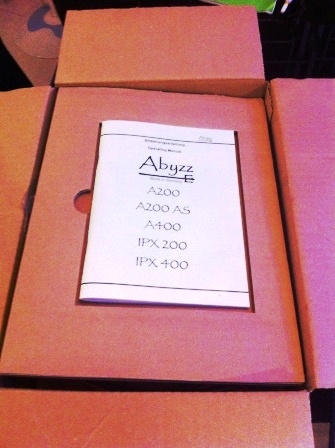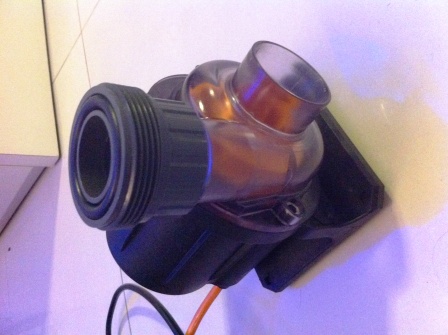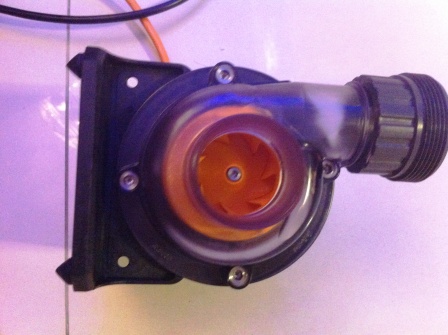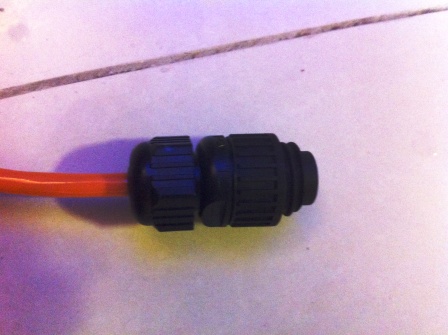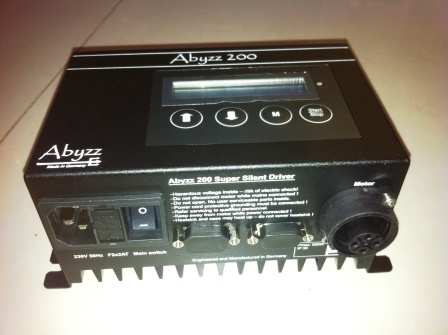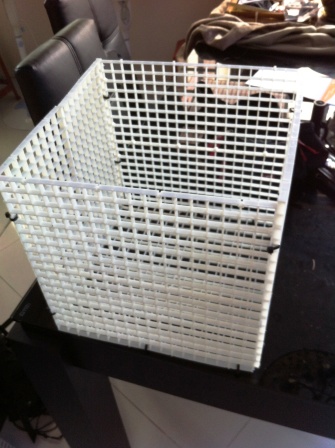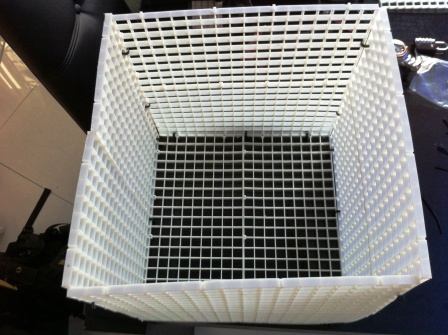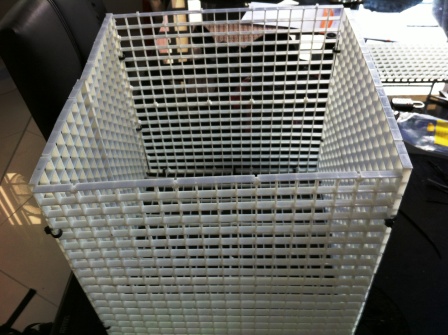-
Posts
8,253 -
Joined
-
Last visited
-
Days Won
31
Content Type
Profiles
Forums
Gallery
Everything posted by Harlequinmania
-
Click through to see the images. The Western Australian Mandarin Dragonet (Synchiropus picturatus occidentalis) is a subspecies of the the common Green Spot Mandarin. Its limited distribution around Western Australia (Southeast of Elphik's Knob, northeastern end of Rosemary Island, Dampier Islands) and its reclusive habits make in-situ sightings very rare and captive specimens even rarer. Imagine our excitement when we received not only a photo but a video of the Western Australian Mandarin Dragonet. The video comes to us courtesy of Vebas Aquariums in Perth, Australia, where this specimen currently resides in their show tank. Even in captivity, sightings of this mandarin is said to be a rare event. " height="360" style="width: 640px;" type="application/x-shockwave-flash" width="640"> "> "> A common Green Spot Mandarin When compared to the common Green Spot Mandarin (S.picturatus) pictured on the right, the Western Australian subspecies is what we can best describe as "inversely colored." The main body is orange (vs green), and most of its spots lack the dark interior pigmentation thus giving them a ring-like appearance. Numerous distinctive green/teal dots cover the Western Australian Mandarin Dragonet's entire body, including dots within the rings. This subspecies also has dual parallel white stripes running across each eye similar to sixline wrasses. Very little information exists about this subspecies, and no information exists about its captive care that know of. In all likelihood, the Western Australian Mandarin Dragonet has similar requirements as the Green Spot Mandarin. But chances are, you'll never encounter one in your lifetime. View the full article
-
Click through to see the images. The Western Australian Mandarin Dragonet (Synchiropus picturatus occidentalis) is a subspecies of the the common Green Spot Mandarin. Its limited distribution around Western Australia (Southeast of Elphik's Knob, northeastern end of Rosemary Island, Dampier Islands) and its reclusive habits make in-situ sightings very rare and captive specimens even rarer. Imagine our excitement when we received not only a photo but a video of the Western Australian Mandarin Dragonet. The video comes to us courtesy of Vebas Aquariums in Perth, Australia, where this specimen currently resides in their show tank. Even in captivity, sightings of this mandarin is said to be a rare event. " height="360" style="width: 640px;" type="application/x-shockwave-flash" width="640"> "> "> A common Green Spot Mandarin When compared to the common Green Spot Mandarin (S.picturatus) pictured on the right, the Western Australian subspecies is what we can best describe as "inversely colored." The main body is orange (vs green), and most of its spots lack the dark interior pigmentation, thus giving them a ring-like appearance. Numerous distinctive green/teal dots cover the Western Australian Mandarin Dragonet's entire body, including dots within the rings. This subspecies also has dual parallel white stripes running across each eye similar to sixline wrasses. Very little information exists about this subspecies, and no information exists about its captive care that we know of. In all likelihood, the Western Australian Mandarin Dragonet has similar requirements as the Green Spot Mandarin. But chances are, you'll never encounter one in your lifetime. View the full article
-
Click through to see the images. The mutation causes the lobster to produce more of a specific protein that gives the shell the bright blue hue that makes it a true blue beauty. Lobsterman Bobby Stoddard caught this rare lobster in May and it's the first lobster he has seen in his 33 years of lobstering. His father, a lobsterman of 55 years has only seen this phenomenon once before 45 years ago. Knowing that it was rather rare, Bobby attempted to donate it to a local ocean institute; However, they were uninterested in the donation. Until things change, the lobster will reside in a holding tank at Stoddard's place of business. (via Yahoo, CNN) View the full article
-
Click through to see the images. Advanced Aquarist has shared a number of Steve De Neef videos over the past year simply because his work is always top shelf material. Steve's travels throughout the Indo-Pacific have brought us some of the most awe-inspiring coral reef vidoes ever recorded. View the full article
-
Click through to see the images. In February, the Journal of Parasitology reported on an interesting case of a Korean woman and her squidy meal: "Penetration of the mucosa by parasite-like sperm bags of squid: a case report in a Korean woman." Here's the situation: the unidentified Korean woman, age 63, parboiled (partially boiled) a Japanese flying squid, Todarodes pacificus, for her meal. She then proceeded to eat the squid along with its internal organs. At some point during her meal, she took bite and spit it out after experiencing severe pain in her mouth. She then experienced "a pricking and foreign-body sensation" in her mouth and was taken to a hospital for examination. Doctors at the hospital found "twelve small, white spindle-shaped, bug-like organisms stuck in the mucous membrane of the tongue, cheek, and gingiva" of her mouth, which were subsequently removed and identified. As it turned out, all twelve of the white spindle-shaped things were positively identified as squid spermatophores. Danna Staaf over at the Squid a Day blog describes spermatophores as having "an ejaculatory apparatus, which can expel the sperm mass quite forcefully, and a cement body for attachment." Each of the spermatophores were doing exactly what they were designed to do: attach to a membrane and eventually release their payload. Danna also mentions there is another report of this happening back in December 2011. However this was with an uncooked squid. Lesson for the day: completely cook your squid and do not eat the internal organs! (via Science 2.0 / Squid a Day) View the full article
-
Click through to see the images. About Flashback Fridays: Every Friday, Advanced Aquarist will repost a blog article from this week one year ago. With all the content we publish, we want to share the timeless and interesting articles for our new readers as well as regulars who may have missed the origin A n I n d o o r T r o p i c a l T h u n d e r s t o r m ! Aquarium: 120" x 80" x 24" (950 gallons) | 200 x 300 x 60 cm (3600 liters) Lighting: 12 x 100 watt LED (equivalent 12 x 250 Watt HQI) This is probably the most elaborate LFS tank you will ever see. The folks at HPAquaristik recently uploaded a series of short videos of their new main reef display. Suffice it to say, I am in awe of the thought that went into the storm-simulation system of their massive system. The LED lighting system (minus rain system) We're not just talking about random cloud cover simulation using LED lighting (ho-hum application these days). We're talking about a full blown storm simulation system, with beautifully simulated ambient lights and "lightning strikes"... and actual rainfall! Freshwater is fed into an irrigation system suspended over the tank; Each day, a simulated thunder and rain storm showers the main display with freshwater for a couple of minutes. This is without a doubt the most elaborate evaporation top-off system I know. It's far from my place to offer constructive criticism on this awesome system, but integrating pump programs with the lighting system could create an even more spectacular simulated storm. Unless you're a serious malcontent, there's no way these videos do not inspire you: A full walk-around of the 950 gallon (3,600 liter) reef display " height="360" type="application/x-shockwave-flash" width="640"> "> "> Simulated thunderstorm, complete with rainfall! " height="360" type="application/x-shockwave-flash" width="640"> "> "> Above-the-tank view of the simulated rainstorm " height="360" type="application/x-shockwave-flash" width="640"> "> "> A short video demonstrating simulated cloud cover " height="360" type="application/x-shockwave-flash" width="640"> "> "> View the full article
-
Click through to see the images. Published today in Coral Reefs, Jean-Paul Hobbs and Hisham Macrae report on just that in their paper "Unusual weather and trapped coral spawn lead to fish kill at a remote coral atoll." Die-off. The event happened this past January at an eastern atoll in the Cocos Islands in the Indian Ocean. The conditions were just right: low wind speeds with winds out of the west caused a stall of the lagoonal flushing that normally occurs at this time of year. The western winds blew coral spawn slicks (picture (a) at right) into the lagoons where they stalled. This resulted in a mass fish die-off over the next several days (pictures ( and © at right) "due to hypoxia caused by a combination of oxygen consumed by coral spawn, oxygen depletion by decomposing coral spawn and other dead organisms, and lack of lagoon flushing." Hobbs and Macrae estimate that 200,000 fish died in the event. They found fish from the following taxa died in decreasing order: "Pomacentridae (damselfish), Holocentridae (squirrelfish / soldierfish), Gobiidae (gobies), Apogonidae (cardinalfish), Acanthuridae (surgeonfish / tangs), Epinephelidae (grouper), Labridae (wrasses), Siganidae (rabbitfish), Scaridae (parrotfish), Mullidae (goatfish), Nemipteridae (breams), Monocanthidae (filefish), and Tetradontidae (pufferfish) ... [in addition to] blacktip reef sharks, moray eels and various invertebrates (e.g. octopus, crabs)." They also noted branching Acropora and Pocillopora died as well. The mass mortality will have a significant impact on both the local people that rely on the lagoon for food and their livelihood and on fish and other animals that relied the reef for shelter and food. (via Coral Reefs) View the full article
-
Click through to see the images. " height="383" style="width: 680px;" type="application/x-shockwave-flash" width="680"> "> "> This is the mixed nano reef of Pierce Schreiber. ADA 60cm-f aquarium: An 8.5 gallon, low-profile (7" height), rimless, low-iron glass aquarium. MAME overflow with a sump Giesemann Infiniti 150W HQI 4 T5 Ecotech Marine Vortech MP10 pump View the full article
-
Hi, Selling my 8 month old set of 5ft double tube DE T5 (80W) lighting . Come with one tube of ATI and and one gisemen Tube which is also about 8 month old. Looking at $ 280.00 Deal in CCK ave 3.
-
Researchers have found that male African cichlids vocalize during courtship, and that females' sensitivity to these sounds increases when they are ready to mate. View the full article
-
The common ancestor of all jawed vertebrates on Earth resembled a shark, according to a new analysis of the braincase of a 290-million-year-old fossil fish that has long puzzled paleontologists. Research on Acanthodes bronni, a Paleozoic fish, sheds light on the evolution of the earliest jawed vertebrates and offers a glimpse of the last common ancestor before the split between the earliest sharks and the first bony fishes -- the lineage that would eventually include human beings. View the full article
-
Click through to see the images. Nudibranchs of the genus Phestilla are somewhat akin to the late American comedian Rodney Dangerfield - They can't get no respect. Nor should they get any if you enjoy keeping corals in captivity. While Montipora-eating nudibranchs are well-recognized, and Acropora-eating flatworms send waves of fear and loathing among dedicated SPS keepers, the coral-eating nudibranch genus Phestilla gets little attention, although its presence in a reef aquarium can prove detrimental or deadly to a number of coral species. They are voracious feeders and a single adult can strip away as much as 10 square inches (25 square centimeters) of coral tissue in one day. Even worse, they are generally nocturnal, spending their days hidden from view only to emerge at night to begin their destruction. Searching the aquarium at night with a flashlight can be a lesson in frustration since these nudibranchs are well-camouflaged and blend in well with the tissues of its prey (See Figure Two below for an excellent example). Scant evidence of their existence is apparent at first, with perhaps poor coral polyp expansion, slight discoloration, and a bare spot here and there being the initial clues. Unless immediate action is taken, the affected corals have only a few days at most to live. Figure One. Innocuous in appearance, the parasitic nudibranch Phestilla is swift and certain death to some corals. Probably Phestilla sibogae or P. lugubris. Photo by the author. Kingdom: Animalia Phylum: Mollusca Class: Gastropoda Subclass: Opisthobranchia Order: Nudibranchia Suborder: Aeolidina Family: Tergipedidae Genus: Phestilla Distribution Phestilla nudibranchs have a wide geographical distribution, and have been reported from waters of Australia, Indonesia, Guam, Hawaii, the Philippines, Pacific Panama, Iran, Egypt, Thailand, Palau, Kenya, Tanzania, and India. Since one of Phestilla's coral hosts ('Sun Corals' - Tubastrea spp.) are now considered an invasive species in the Atlantic, one has to wonder if Phestilla is there as well. Taxonomy and Phestilla Those researchers - taxonomists - concerning themselves with the classification of living organisms hold one of the most secure jobs - they are constantly sorting and re-sorting, leaving their practice, where order is the goal, in a constant state of disarray. To make this point, the exact identification of at least some coral hosts' (especially finger and lobe stony corals -Porites) species status and their parasites (Phestilla) mentioned in this article are in debate among researchers. Nudibranch taxonomy is not a research field heavily populated so descriptions of new species are sporadic, yet there is little doubt that many new species await discovery. These are some of the described species, or those with enough morphological differences to make researchers suspect they are species: Phestilla lugubris (Also described a P. sibogae) Adult size: 40mm (~1.5 inches) Color: Assumes the color of its host hence coloration depends upon the host color and pigment content of zooxanthellae, but usually whitish, beige, dark brown, sometimes greenish. Known Hosts: Porites compressa, P. lutea and/or P. lobata (the latter two are personal observations and no attempt was made to identify these corals to the species level) Foods: Porites coral tissue, zooxanthellae (Symbiodinium)* Notes: Faucci et al., 2007 believe P. lugubris and P. sibogae are different species based on observation of adult and egg mass sizes, and nudibranch morphology Phestilla melanobranchia Maximum Adult size: 40mm (~1.5 inches) Color: Red, yellow, orange, dark brown or black Known Hosts: 'Sun Corals' such as Dendrophyllia elegans, Tubastrea aurea, Tubastraea coccinea, Tubastraea diaphana* Food: Adults eat Dendrophyllia tissues, veliger eat green and brown algae (Duneliella and/or Phaeodactylum triconutum, respectively) Life Span: ~140-160 days Notes: Males sexually mature at 10mm length, females at 20mm (at an age of ~60 days). See Figure Two for a photo of P. melanobranchia. Figure Two. Phestilla melanobranchia blends in almost perfectly with its host. It is at the 10 o'clock position. Photo courtesy Dr. Art Reed. Phestilla minor Adult size: 7mm (~1/4 inch) Color: Translucent white to cream Known Hosts: Hawaiian Finger Coral (Porites compressa), Small Mound Coral (Porites annae), and the Mound Coral (Porites lutea)* Life Span: ~140 days Notes: Sexually mature in about 38 days Phestilla minor #2 Host: Mound Coral (Porites lutea) Phestilla panamica Maximum Adult size: 24mm (~1 inch) Host: The Lobe Coral (Porites lobata) Coloration: Body is translucent orange with grey-brown cerata with yellow tips. Location: Pacific coast of Panama Note: Resembles P. sibogae in morphology (Faucci et al., 2007). P. panamica is the only known Phestilla species from the Americas. Phestilla sibogae - See P. lugubris Phestilla species #1 Hosts: Plate Coral (Porites rus), Mound Coral (Porites lutea) Location: Palau Phestilla species #2 Hosts: Flower Pot Corals (Goniopora species). Some Goniopora species are difficult to keep in captivity. It has long been my view that inadequate feeding is the cause (I published this viewpoint in the mid-1990's in Freshwater and Marine Aquarium magazine). Now we know parasitic nudibranchs could be a cause of these corals' losses as well. *Host Fidelity Faucci et al. (2007) report a possible case of host-switching, where Phestilla species jumped from their primary food source (Porites corals) to other corals (Goniopora and Tubastrea spp.). If this is indeed the case, the implication is frightening, and conjures the possibility of Phestilla nudibranchs finding alternative food sources when normal hosts are not available. Haramaty (1991) found at least some zooxanthellae ingested by Phestilla sibogae remained intact, were not digested (or at least not immediately), and were able to photosynthesize at relatively low light levels (45 µmol·m²·sec, or about 2,250 lux). This leads to the interesting possibility that this species benefits by gaining translocated nutrition from the zooxanthellae. Pacific Porites corals generally contain zooxanthellae (specifically zooxanthellae Clade C15) possessing the remarkable ability to survive in conditions of low light. Thus even cryptic nudibranchs could gain nutritionally even when hidden from strong light during the day. Reproduction Many Phestilla species are prolific spawners after becoming sexually mature in only a few weeks after hatching. These animals are gonochoric (separate sexes) and females can lay several thousands of eggs every day until they are near the end of their short lifespans. Hence we can calculate a single female may lay as many as 320,000 eggs in about 2 months. It is thought that heavy predation of these nudibranchs by certain fishes, crabs and mantis shrimp has resulted in the reproductive strategy of 'Reproduce quickly and abundantly - life is short!' See Figure Three. Figure Three. A Phestilla nudibranch with multiple spiral egg masses found of the underside of a Porites coral in Hawaii. Note the egg mass on the far left - most of the eggs within it have already hatched, leaving only a transparent ribbon. Photo by the author. Quarantine and Chemical Control When I attended the 2011 MACNA conference in Des Moines, I was given a small sample of a product called 'CoralRx One Shot'. The small tube held ~6 milliliters of a product said to act a 'coral dip', where the coral is placed for a few minutes in a container containing a mixture of aquarium water and CoralRx. This product reportedly kills parasites outright, or causes them to abandon their host. It is said to work on parasitic copepods and nudibranchs. Would it work on Phestilla nudibranchs? My observations are not meant to be an in-depth analysis; however, I did wonder what effects this treatment would have on water quality. My first test broke a cardinal rule learned during HazMat First Responder training - I opened the container and smelled the contents. My best guess is that CoralRx is a natural terpene as it had a smell similar to pine oil, not unlike other coral dips on the market. A quick visit to the company website (www.coralrx.com) provided mixing directions, as well as a link to a Product Review published in Advanced Aquarist: http://www.advancedaquarist.com/2009/4/aafeature2 This review recommends a dosage of 8 milliliters per gallon. I mixed 6 milliliters with one gallon of aquarium water. I checked the mixture's pH with a calibrated meter, and found it did not differ from that of the aquarium's water. I had previously collected a Phestilla specimen (as luck would have it I could find only one) and placed it in a clean glass fingerbowl containing about 200 milliliters of water. During the night, the nudibranch laid two egg masses on the glass. This indicated two things - it was obviously a female and she was not near the end of its expected lifespan (Phestilla nudis are known to live for a few weeks after they stop laying eggs). The fingerbowl was placed in the contents of the bucket holding the CoralRx solution and a little gentle mixing replaced the aquarium water with the coral dip mixture (I did not want to allow the nudibranch to be exposed to the air or be crushed by its own weight while out of water). ThePhestilla showed rapid movement and squirming (subjectively interpreted as 'displeasure') after only a few seconds of exposure to CoralRx. After about 15 minutes, the CoralRx solution was again carefully replaced, this time with fresh aquarium water. The next morning the Phestilla was dead, and had disintegrated with only its cerata covering the bottom of the bowl. The egg masses appeared unharmed and remained intact until the contents were discarded 5 days later (no attempt was made to hatch the eggs). I made an assumption that the egg masses would have rapidly deteriorated (as the adult had) if they were killed by the treatment. I also placed a small piece of live rock in the solution. The next morning, I removed a dead crab, but a small sea urchin did not seem to the affected. There was some unidentifiable debris (remains of sponges?) covering the bucket's bottom. This very limited observation suggests CoralRx may be effective against Phestilla nudibranchs, although the eggs are apparently not harmed. CoralRx seems to have effects on select invertebrates or life stages. Further experimentation is needed to confirm these results. As a footnote, the manufacturer recommends CoralRx as a precautionary dip, and does not recommend it for whole tank treatment. Natural Controls: Predators of Predators and Water Motion If quarantine and prophylactic measures fail and the evil genie is out of the bottle, natural methods to control Phestilla populations are possible. These include the Hawaiian 'Old Lady' Wrasse called Hinalea Luahine (Thalassoma ballieui), Saddle Wrasse (Thalassoma duperrey), Threadfin Butterflyfish (Chaetodon auriga), Aerolated Xanthid Crab (Pilodius aerolatus), Xanthid crab (Phymodius monticulosus), Swimming Crabs (Thalamita spp.), and the nasty little Mantis Shrimp (Gonodactylus falcatus) as predators of this species. Some may be surprised when seeing Chaetodon auriga included as it known to be a 'coral-picker.' The rationale for including it is as follows. First, corals targeted by Phestilla are doomed without predatory pressures to keep the nudibranch population under control (or better, eliminated). Second, some studies show at least some Chaetodon auriga specimens obtain only a small fraction of their nutritional needs from corals, in fact, they are one of the easier butterflyfishes to maintain in captivity and can be trained to eat a variety of prepared and frozen foods. If the fish proves troublesome, its removal is probably easier than removing the corals or tearing the tank down. Predators of Phestilla show food size preferences. Thalassoma duperrey prefers larger nudibranchs, as does the crab Phymodius monticulosus. The Threadfin Butterflyfish eats large and small nudibranchs. There is little danger of fishes being harmed by Phestilla since these mollusks cannot concentrate nematocysts gathered from their coral hosts into their cerata, thus the nudibranchs do not sting. One point should be clear: Predators of Phestilla nudibranchs cannot eat them if they are not within reach. A recurring tidbit of advice seems common within internet threads addressing issues with nudibranchs: 'Blow' the nudibranchs off corals by any means necessary including fanning them with your hand or using a baster. What does this tell us? An outbreak of predatory nudibranchs could be prevented or controlled by vigorous water motion. Water motion is always poor in aquaria when compared to that seen on real reefs. This concludes our quick look at Phestilla nudibranchs. A listing of resources for those wishing to learn more is presented at the close of this article. Embletonia: 'Montipora-eating Nudibranchs' Figure Four. Embletonia, a threat to Montipora corals. Photo by the author. Kingdom: Animalia Phylum: Mollusca Class: Gastropoda Subclass: Opisthobranchia Order: Nudibranchia Suborder: Aeolidina Family: Embletoniidae Genus: Embletonia If you do not know the names of things, the knowledge of them is lost too. -- Carl Linnaeus, 1751 At last we have the real name for these nudibranchs which is fortunate - It gives me an excuse to refrain from calling them some of the rather nasty names I've heard them called. Perhaps we should give them a break as they are only doing what they do, fulfilling their role in the natural scheme of things. They are a 'problem, because we have created an artificial environment where Embletonia can exist and thrive. The same points for control of Phestilla nudibranchs made above can apply to Embletonia: First and foremost, quarantine all new additions to an aquarium. If this proves unsuccessful, research and define natural predators and increase water motion. Although discovery of the scientific name for Montipora-eating nudibranchs may seem trivial, it is not as it allows access to information found in peer-reviewed journals on the internet. A quick internet search found this information. There are only two described Embletonia species: E. gracilis: Found off the southwestern side of Africa (just barely into the Atlantic) and across the Pacific in waters off Mexico, the Indo-Pacific (including Australia, New Zealand, Indonesia, Philippines) and Japan. Said to eat hydroids. E. pulchra. A cold-water species of the North Atlantic. Undescribed species. At present, the 'Montipora-eating nudibranch' falls into this category. If there is a bright side in finding Embletonia, it would be furthering our understanding of their life and reproductive cycles and describing their predators. Questions? Comments? Leave a message below in the Comment section. For a quicker reply, contact me at RiddleLabs@aol.com. References and Suggested Reading Faucci, A., R. Toonen, and M. Hadfield, 2007. Host shift and speciation in a coral-feeding nudibranch. Proc. R. Soc. B, 274, 1606:111-119. Gochfeld, D. and G. Aeby, 1997. Control of populations of the coral-feeding nudibranch, Phestilla sibogae, by coral reef fishes and crustaceans. Mar. Biol., 130:63-70. Haramaty, L., 1991. Reproduction effort in the nudibranch Phestilla sibogae: Calorimetric analysis of food and eggs. Pac. Sci., 45, 3: 257-262. Harris, L., 1975. Studies on the life history of two coral-eating nudibranchs of the genus Phestilla. Biol. Bull., 149: 539-550. Control of populations of the coral-feeding nudibranch Phestilla sibogae by fish and crustacean predators. Mar. Biol., 130, 1: 63-69. Rudman, W., 1982. A new species of Phestilla; the first record of a corallivorous aeolid nudibranch from tropical America. Journal of Zoology, London 198: 465-471 Rudman W., 1981. Further studies on the anatomy and ecology of opisthobranch molluscs feeding on the scleractinian coral Porites. Zoological Journal of the Linnean Society 71: 373-412. Related Websites www.seaslugforum.net www.nudipixel.net www.seaslugsofhawaii.com View the full article
-
Despite Europe's marine fauna being the best documented on Earth, there are still some new species to be discovered. This is the case of Uroptychus cartesi, a crab between 5 cm and 7 cm in size found at more than 1400 deep in the underwater mountains facing the Galician coast (Spain). Its closest relative can be found in the Caribbean Sea. View the full article
-
Despite Europe's marine fauna being the best documented on Earth, there are still some new species to be discovered. This is the case of Uroptychus cartesi, a crab between 5 cm and 7 cm in size found at more than 1400 deep in the underwater mountains facing the Galician coast (Spain). Its closest relative can be found in the Caribbean Sea. View the full article
-
Click through to see the images. The research was recently published on the journal Trends in Ecology and Evolution by George Roff and Peter Mumby. The study's goals were to compare the macroalgal growth of the Caribbean, Indian, and Pacific regions as a way to benchmark the transferability of concepts between regions. In general, the Caribbean is characterized as a region with low resilience when it comes to macroalgae takeover when the conditions are right. In this paper, Roff and Mumby attempt to answer the question of why this might happen. They cite common themes such as "faster rates of macroalgal growth, higher rates of algal recruitment, basin-wide iron-enrichment of algal growth from aeolian dust, a lack of acroporid corals, lower herbivore biomass and missing groups of herbivores" as possible reasons. Their data also suggests that the Indo-Pacific region would need to have significant degradation in order to exhibit these same traits as the Caribbean. "Seaweeds bloom four times faster in the Caribbean than the Pacific Ocean", exclaims study author, Dr George Roff, of the University of Queensland. "This helps explain why corals in the Caribbean seem to be such weak competitors against seaweeds. Coauthor, Professor Peter Mumby, adds, "Seaweeds are able to bloom when we loosen their controls, either by polluting the sea with fertilizers or catching too many parrotfish, who treat seaweed as a delicacy. We now know that seaweeds will bloom if we give them the slightest chance. This means we should redouble our efforts to control pollution and fishing of parrotfishes". "It is intriguing to see such variability in seaweed behaviour around the world", says Dr Roff. "We raise a number of possible explanations that scientists will test over the next few years". (via ScienceDaily, Coral Reef Studies) View the full article
-
Older people who take omega-3 fish oil supplements are probably not reducing their chances of losing cognitive function, according to a new Cochrane systematic review. Based on the available data from studies lasting up to 3.5 years, the researchers concluded that the supplements offered no benefits for cognitive health over placebo capsules or margarines, but that longer term effects are worth investigating. View the full article
-
This is the new pump which i got recently.. Was excited to see how the wave and random mode works. I had two main pump in my sump which is now this new Abyzz pump together with the Ehiem 1264. I tried running only the new Abyzz pump on wave and random mode, expecting to see a fluctuation in the water level in the sump tank going up and down, but surprising the fluctuation is almost unnoticeable.
-
Finally some time to update my tank thread.. For the past few month , i make some changes / additional toys i had to my new tank which include adding a small Deltec calcium reactor to supplement on the 3 part, a new main pump, and a Kalk reactor .
-
Just to share this simple idea of DIY your own betta box for those reefer like me who couldn't find a suitable size Betta box for tempory housing of their fish or for use on trapping their fish inside the tank. Material needed : Plastic egg crate Cable tie Stylo foam block ( Or anything that can keep the egg crate afloat ) Below is some photo of the simple DIY betta box i make for housing of bigger fish in my tank.
-
Click through to see the images. Time-laspe videos can really make corals "come alive." When perfectly composed, meticulously illuminated, crystal clear video is synchronized to dramatic music, the result is bonafide works of art worth watching and sharing for years to come. If you haven't seen these videos before, prepare yourself for total awesomeness. View the full article
-
This month, we are featuring our new winner for the Tank of the Quarter !! Mengyang_neo aka Gary has been awarded as the winner. Congratulation to gary for wining , and Kudos to him again for the passion and dedication toward this hobby ! Title : My Dream Tank Brief Introduction of your history of setting up your tank It all started in 2007 when my bro in law decom and pass me his full set of 4x2x2.5ft tank and equipment, as it is a new hobby to me; I paid a lot of fee and earn it the hard way. Starting with a LPS tank, then when I enlisted, I changed it to a FOWLR. It is really very disappointing with so many failures that I decided maybe I should just decom or change a new tank and have a new start. I change to a 5x1.5x2ft tank, going full zoas with LPS and slowly into full SPS, the journey is fun and I know a lot of reefers and close friend in this fruitful journey. Starting of SPS is plain coincident as I am the lucky winner for Dr Cedric lucky draw and I get to try SPS FOC. From the few frag, I manage to hold the colour and start to get more and more SPS. Advice from Cedric and other SPS keeper are very helpfully and I get to keep SPS more successfully. With SPS getting more and more, manual dosing seems impossible and very troublesome. So I get a dosing pump and keeping the parameter constant becomes a lot easier. With all the success, I tried to go Full SPS with angels; I stock up too fast and end up crashing my tank, lost a lot of SPS. Lucky I do trade with other reefer so I get to get back some of my SPS. With all the up and down, I decided to once again get a new tank and do all the basic stuff and keeping everything consistence. Finally this year with a clear idea of what my tank is going to be, I change to my present tank – My Dream Tank Tank details and specification Main Tank size ; 5x2.4x1.6ft Sump tank size ; 4x1.8x1.5ft Types of Glass / thickness ; 12 mm crystal clear glass for 3 side of my main tank Total Water volume of system ; around 600 litres Tank system parameter Calcium - ca ; 400 Alkaline - KH ; 8-8.5 Magnesium – mg ; 1300 Tank system profile ( Equipments list and lighting period ) Skimmer - H&S Skimmer Return Pump - 2 x Eheim 1264 Wavemaker - 2 x tunze 6095 ,and muilt controller 7096 Chiller - Daikin compressor with coil drop in Lighting - 2 x 250w MH- 4hrs and 2 x 80w De-lighting Retrofit -9hrs Reactor - Dosing pump Addictive used I do use a dosing pump to dose Ca and Kh and change a pail of water every week. During water change, I will add zeovit Coralsnow and Zeozym, I will add coral vitalizer randomly into my tank when I remember. List of live stocks in your tank I am keeping full SPS with zoas and the following list of fishes Yellow tang Picasso clown pair FlameHawk Mystery Wrasse Yellow Wrasse 4 Chromis Some personal Q & A questions 1. Are you a fish guy or a Coral guy ? Ans ; I am a Coral guy 2. What is your main concern when looking around for your reefing equipment Ans ; I will go for trusted German brand or brand that has good after sale support. This is very important for reefing as a lot of thing can go wrong. 3. What is your favorite past time Ans ; Go LFS shopping and chit chat with my group of reefer friends. 4. What is the satisfaction you got from this hobby ? Ans ; The satisfaction is having small achievement like a brown SPS colour up and to have a slide of ocean in your own living room. 5. Any advice for newbie in this hobby ? Ans ; I feel reefing is not difficult with all the equipment available to help reefer, and there are a lot people sharing different method of keeping a successful tank. The problem is all the method mentioned take time, and when I said time, it is not 1-2 days; rather it is 2-3 weeks or maybe months. So be patient and you will be rewarded, consistent is the key. All the Best. Final Acknowledgement and thanks you note Firstly I will like to thanks my family member for their tolerance and understanding for my passion in this hobby. It really bonded the whole family together as it will be a common topic for the whole family, when thing happen to my tank, sometime they are more nervous than me. Lol Next will be my reef buddies cum close friends, whom shared sleepless night chiong shipment or early in the morning whatsapping reefing stuff, you know who you are. Cheer!!!! Last but not least, I want to thank SRC staff and the reefing community for having this platform so that, we reefer can learn and share our experiences. Video



